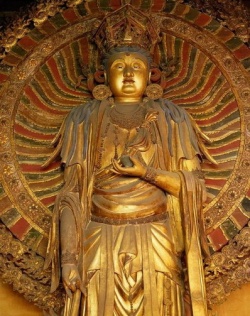Universal Kindness
Samantabhadra (Universal Kindness) is regarded as Adi-Buddha and as first Dhyani - Bodhisattva
Among the ancient Northern Buddhist sects and the unreformed Lamaist sects in Tibet, SAMANTABHADRA was looked upon as Highest Intelligence, a primordial Buddha, or Adi-Buddha. He is figured seated with the legs locked; but unlike the other representations of Adi-Buddha, he has neither crown nor ornaments, and in his esoteric form was represented nude in blue color embracing his Sakti consort in white color.
An Adi-Buddha infinite, omniscient, self-existing, without beginning and without end, the source and originator of all things, who by virtue of five sorts of wisdom jnana and by the exercise of five meditations dhyana evolved five Dhyani Buddhas. When this Adi-Buddha is represented with his female energy, he is called Yogambara and the sakti Digambara [[[Jnanesvari]]].
Samantabhadra Tib.: "Kun tu bzang po"
Tibetan Buddhists believe that the Adi-Buddha, the primordial and highest being, created the Dhyani Buddhas by his meditative powers.
The Five Dhyani Buddhas are celestial Buddhas visualized during meditation. The word Dhyani is derived from the Sanskrit dhyana, meaning "meditation." The Dhyani Buddhas are also called Jinas ("Victors" or "Conquerors") and are considered to be great healers of the mind and soul. They are not historical figures, like Gautama Buddha, but transcendent beings who symbolize universal divine principles or forces. They represent various aspects of the enlightened consciousness and are guides to spiritual transformation.
Each Dhyani Buddha is associated with certain attributes and symbols. Each one embodies one of the five wisdoms, which antidote the five deadly poisons that are of ultimate danger to man's spiritual progress and keep him tied to worldly existence. Buddhists teach that the Dhyani Buddhas are able transmute the five poisons into their transcendent wisdoms. The Tibetan Book of the Dead recommends that the devote meditate on the Dhyani Buddhas so that their wisdoms will replace the negative forces he has allowed to take hold within.
Each Buddha rules over one of the directions of space al one of the cosmic realms of ether, water, earth, fire and air. The Dhyani Buddhas also personify the five skandhas, components that make up cosmic existence as well as human personality. These components are consciousness, form, feeling, perception and volition.
Samantabhadra (also Viśvabhadra, 普賢 Chinese: Pǔxián; Japanese: Fugen) is the Lord of the Truth (理) in Buddhism, who represents the practice and meditation of all Buddhas. Together with Shakyamuni and fellow disciple Manjusri he forms the Shakyamuni trinity. He is the patron of the Lotus Sutra and, according to the Avatamsaka Sutra, made the ten great vows which are the basis of a bodhisattva. Samantabhadra is most commonly described as a bodhisattva himself, although some esoteric traditions regard him as a primordial Buddha.
Literally 'He whose bounty is omnipresent', he represents the Buddhist ideals of Law and Compassion. He is often associated with Manjushri, alongside whom he is one of the three acolytes of Shakyamuni. In Japan this Bodhisattva is mainly worshipped by the Tendai and Shingon sects, and as the protector of the Lotus Sutra by the Nichiren sect.
Samantabhadra was formerly looked upon among Tantric Buddhist sects as the Primordial Buddha, awakened since the very beginning; but his popularity diminished when the dKar-hGya-pa (Red Bonnets) and dGe-lugs-pa (Yellow Bonnets), set up Vajradhara as the Adi-Buddha.
the Yogacharya sects claim that Samantabhadra, instead of Vairochana, was the founder of the Yoga system, and look upon him as the divinity of Religious Ecstasy. Indeed he is the special divine patron in Japan of those who practise Hokkesammai (ecstatic meditation).
Samantabhadra is known also as following:
Tibetan: Kun-tu bzang-po
Mongol: Qamugha Sain
Vietnamese: Phổ Hiền Bồ Tát
Unlike his more popular counterpart Manjusri, Samantabhadra is only rarely depicted alone and is usually found in a trinity on the right side of Shakyamuni, mounted on a white elephant. In those traditions that do accept the Avatamsaka sutra as its root instruction Samantabhadra and Manjushri flank Vairocana Buddha, the central Buddha if this particular sutra. Puxian is sometimes shown in Chinese art with feminine characteristics, riding an elephant with six pairs of tusks while carrying a lotus leaf parasol, with similar dress and features to some feminine depictions of Kuan Yin.
Among those esoteric traditions that treat Samantabhadra as the Primordial Buddha, he is always represented naked, with a dark blue body, in union with his consort Samantabhadri
